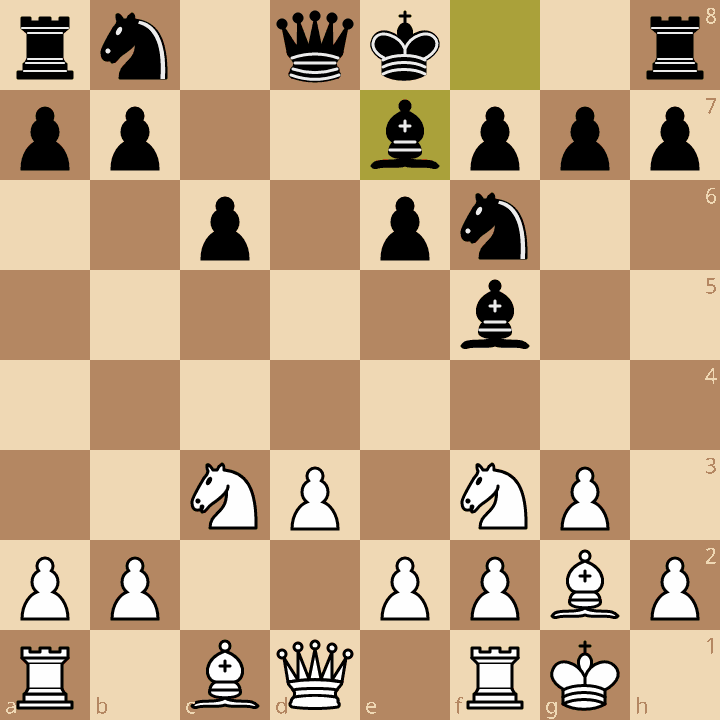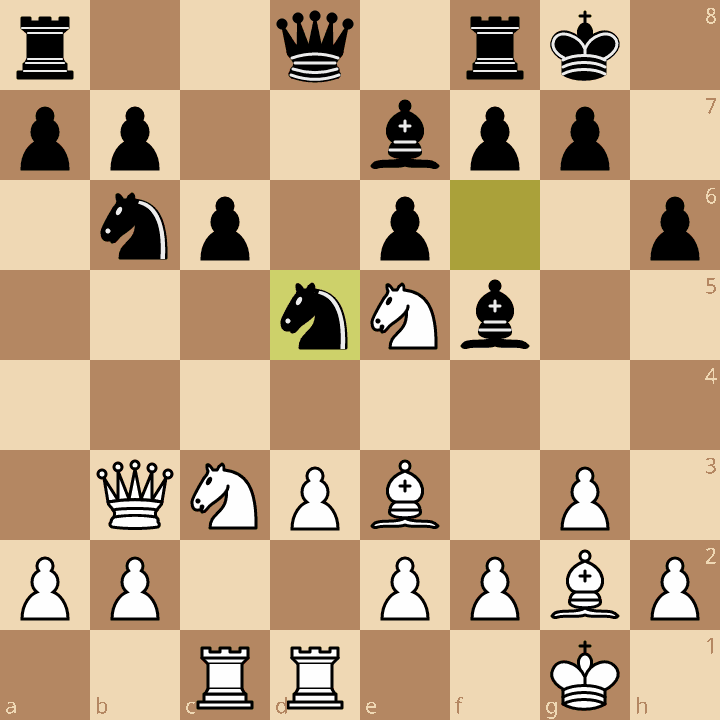Final game. I get the White pieces against my first round opponent. 2.5/3, whereas he’s been making a comeback — winning this game means he would potentially be in the prize money.
Let’s get to it.
Time Control: 90 minutes with a 30-second increment per move
White: Me (1666 USCF)
Black: Anirudha Menon (1677 USCF)
1.c4 d5
This is known as the “Anglo-Scandinavian Defense” — makes sense. 1.e4 d5 is the Scandinavian Defense proper, but in this case Black has played 1…d5 against the English.
2.cxd5 Qxd5 3.Nc3 Qd8
4.g3?!
My instinct was to go for 4.d4 (4.e4 was another option) but I chose this line due out of a desire to “play the English”, rather than playing chess. Already I feel like I was having some mindset problems and elevating “style” over what came to me naturally. 4.g3 is not a bad move, but it’s indicative of a flaw in my own thinking for the reasons I chose it.
4…Nf6 5.Bg2 c6 6.Nf3 Bf5 7.d3
7.d4! or 7.Nh4 were both good. For instance after Nh4, 7…Bg6 8.Nxg6 hxg6, Black doesn’t really have a kingside initiative. Probably I had hallucinated here, thinking that black had the ability to push a pawn storm and use the g3-pawn as a hook — but Black has no h-pawn here. Visualization error on my part.
7…e6 8.O-O Be7
9.Be3?!
9.e4! was a strong idea. In my notes after the game I write “ugly but good”, but actually 9.e4 looks really natural and basically gives White a great position. The worry of the ugliness is ill-founded as long as Black has that b7-c6 chain blunting the bishop.
9…Nbd7 10.Rc1 h6 11.Qb3
11.Nd4! was another idea I was looking at. I rejected it, preferring development. But after 11…Bh7? 12.Bxc6! bxc6 13.Nxc6 Qc7 14.Nb5! was very strong.
11…Nb6 12.Ne5 O-O 13.Rfd1 Nfd5
In my notes: “I am shaking my head a lot as I look through this game. Nerves got to me and I think that I missed a lot of obvious ideas.” My play reflects a lack of confidence in what I was supposed to do. A lot of this was simply unfamiliarity in a very new opening for me. But I do remember being really nervous. My opponent was playing confidently, and compared to the first round in which he was tilting, he seemed to have controlled his emotions very well, and I was starting to play badly and feel the tilt myself.
14.Nxd5 exd5
With the pawn structure like this, Black has no issues at all.
15.Bc5?
A mistake. 15.Bd4 or 15.Nf3 was a much better choice.
15…Bxc5 16.Rxc5 Qd6 17.d4 f6
Here I felt a bit more comfortable. But if Black had gone 17…Rfe8 that would have turned up the pressure quite a bit.
18.Nd3 Rab8?!
19.f3?
Missing a crucial break.
19.e4! was called for. The d-pawn is pinned, so this move gains space and time, while freeing up the position a bit more for White.
19…Nc4!
My opponent wants the rook. But I calculated that I should have some compensation for it.
20.Nf4!?
The idea is to prevent the move Be6.
20.e4 was still a viable option. For instance 20…b6 21.Rxc4 dxc4 22.Qxc4 Be6 22.Qc3 I’m down the exchange for a pawn but a strong central presence.
20…b6?!
20…Be6! Black can go here anyway. After 21.Nxe6 Qxe6, Black would have a comfortable position.
21.Rxc4 dxc4 22.Qxc4 Kh8 23.e4 Bh7 24.Rc1?!
24.Bh3 or 24.Qc3 were better. The d4-pawn needs increased defenders.
24…c5? 25.d5!
After this, I have full compensation for the rook.
25…Rfe8 26.Bh3
I’m actually even slightly better here. I’m starting to get some counterchances back after the disastrous middlegame.
26…Qe5 27.Nd3
27.b4 was tempting, but I didn’t play it because I thought the pawns would be weak. In general, I suffered from a defensive mindset all of this game and went for bad slow ideas instead of interesting active ones.
27…Qd6 28.Nf4
Here I offered a draw. My opponent smirked and then played…
28…f5?! 29.Ne6?!
This was my plan when he played this, but I missed better ideas. For instance, 29.Bxf5 bxf5 30.exf5 is surprisingly strong, though the f5-pawn looks weak. For instance 30…Qf6 31.Qc2 Rbd8 32.Rd1 is incredibly solid for White.
29.Qe5 30.Bxf5 Bxf5 31.exf5 Qxf5
32.Qc3?!
This cheapo is going to cost me. Instead, 32.Kg2!, getting of the back rank, was paramount to survival.
32.Re7 33.Nf4??
I’m panicking and low on time, and unlike in Round 1, I don’t have a good position that I can nurse into a win.
33…Rd8? 34.Rd1 Kg8 35.d6
Desperation is leading me to playing worse and worse moves. The game is over.
35…Red7 36.Nd5 Qf7
37.Qe5 Re8 38.Qf4 Qxf4 39.Nxf4 Red8 40.Re1 Rxd6 41.Re7 Rd2 42.h4 Rxb2 43.Ne6?? Rd1# 0-1
We shook hands and chatted about the game afterward. My opponent made a huge improvement on the second day of the tournament, and this win meant that he would share the first-place prize with me. In the end I walked away with a nice prize amount and a few extra rating points, so it’s hard to complain too much, though this last game showed that I had a lot to work on as far as dealing with my nerves in a productive way and not tilting as a result.
Game in a GIF:
Takeaways:
My instincts in the opening are pretty good — so I need to stick with them and not try to be too rigidly focused on playing a very specific set-up when it isn’t the best.
Playing down the exchange with compensation can be difficult and I need to improve playing with these kinds of imbalances.
It may just be me, but when I feel like offering a draw in a position that still has some play, this shows some weakness and maybe I need to stop doing this.












